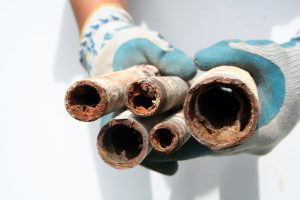The materials used in your home’s plumbing system can have a big impact on water quality, pipe longevity, and even your family’s health. Over the decades, American homes have been built or renovated using a variety of piping materials—some of which are now considered outdated, hazardous, or simply prone to failure.
Knowing what your pipes are made of isn’t just a curiosity. It’s a crucial piece of information for protecting your home and the people in it. Let’s talk more about what might be lurking behind your walls, and whether you should consider whole house repiping in Sterling, VA.
Common Plumbing Pipe Materials (Past and Present)
- Lead – One of the oldest piping materials used in American plumbing, lead was common in homes built before the 1940s. Unfortunately, lead is toxic, and prolonged exposure, even in small amounts, can lead to serious health issues, particularly in children. Although lead service lines are now illegal, many older homes still have hidden lead components or solder.
- Galvanized Steel – Popular in homes built between the 1920s and 1960s, galvanized steel pipes are steel pipes coated in a layer of zinc to prevent rusting. Over time, the zinc erodes, leading to internal corrosion, reduced water pressure, and rusty water. These pipes are often nearing the end of their useful life.
- Copper – Introduced widely in the mid-20th century and still in use today, copper piping is highly durable and resists corrosion. However, some early copper pipes were joined with lead-based solder, and pinhole leaks can develop as the material ages.
- Polybutylene (PB) – Used in millions of homes from the late 1970s through the mid-1990s, polybutylene was hailed as a cheap and easy-to-install alternative. Unfortunately, it degrades when exposed to chlorine in municipal water, leading to sudden pipe failures and water damage.
- PVC and CPVC – These plastic alternatives are corrosion-resistant and cost-effective. CPVC, in particular, can handle hot water better than standard PVC. While generally safe, improper installation or poor-quality materials can still lead to leaks over time.
- PEX (Cross-linked Polyethylene) – A modern favorite, PEX piping is flexible, resistant to scale and chlorine, and easy to install. It has become the go-to material for many new construction and repiping projects due to its reliability and longevity.
The Risks of Aging Plumbing Materials
Outdated materials don’t just pose a risk of leaks—they can affect your water quality and the safety of your drinking water. Lead and deteriorating galvanized pipes can leach contaminants into the water supply. Polybutylene and corroded copper may cause pipe bursts that result in costly water damage.
Additionally, many older plumbing systems are a patchwork of materials added during repairs and remodels, which can lead to compatibility issues and hidden weaknesses in the system.
Why Schedule a Plumbing Inspection?
A professional plumbing inspection can reveal exactly what materials are in your home and whether any are unsafe or nearing failure. With camera inspections and other modern tools, plumbers can assess your system without tearing into walls.
Considering Whole-House Repiping
If your home has lead, polybutylene, or badly corroded galvanized steel pipes, whole-house repiping is a wise investment. Replacing old pipes with modern, code-compliant materials like PEX or copper ensures safe drinking water, fewer leaks, better water pressure, and peace of mind.
Don’t wait for a plumbing emergency to find out what’s in your walls. Schedule a plumbing inspection today and talk with our team about whether repiping is the right next step for your home.
AllTech Services, Inc. is your trusted resource for all your plumbing, heating and cooling concerns. Contact us today!


